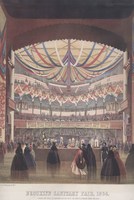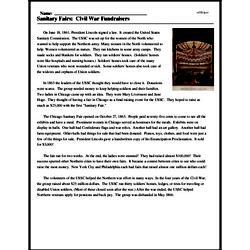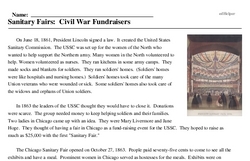Sanitary Fairs: Civil War Fundraisers
On June 18, 1861, President Lincoln signed a law. It created the United States Sanitary Commission. The USSC was set up for the women of the North who wanted to help support the Northern army. Many women in the North volunteered to help. Women volunteered as nurses. They ran kitchens in some army camps. They made socks and blankets for soldiers. They ran soldiers' homes. (Soldiers' homes were like hospitals and nursing homes.) Soldiers' homes took care of the many Union veterans who were wounded or sick. Some soldiers' homes also took care of the widows and orphans of Union soldiers.
In 1863 the leaders of the USSC thought they would have to close it. Donations were scarce. The group needed money to keep helping soldiers and their families. Two ladies in Chicago came up with an idea. They were Mary Livermore and Jane Hoge. They thought of having a fair in Chicago as a fund-raising event for the USSC. They hoped to raise as much as $25,000 with the first "Sanitary Fair."
The Chicago Sanitary Fair opened on October 27, 1863. People paid seventy-five cents to come to see all the exhibits and have a meal. Prominent women in Chicago served as hostesses for the meals. Exhibits were on display in halls. One hall had Confederate flags and war relics. Another hall had an art gallery. Another hall had farm equipment. Other halls had things for sale that had been donated. Pianos, toys, clothes, and food were just a few of the things for sale. President Lincoln gave a handwritten copy of his Emancipation Proclamation. It sold for $3,000!




